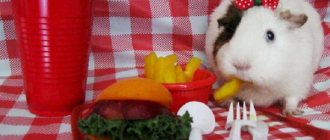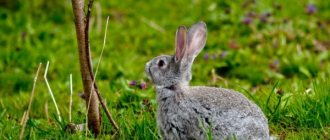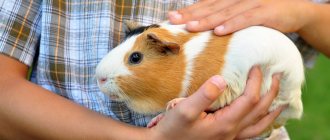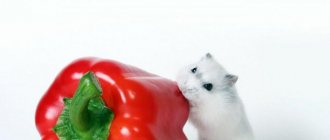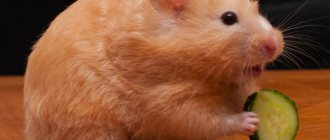Even experienced livestock breeders ask questions: what to feed their pet, whether it is possible to give certain products. Before getting a guinea pig, you should find out which foods will benefit the animal and which may harm its health. A guinea pig's daily menu should include vegetables, fruits, berries and cereals. Many vegetables and fruits can even be offered to your pet along with the peel. It is important to remember that not all foods that guinea pigs eat are equally beneficial for them. What rodents can eat and what they cannot feed a guinea pig is discussed in this article.
Vegetables
Can guinea pigs have radishes?
It is permissible to use only radish tops. The root vegetable contains essential oils that can cause irritation to the mucous membranes and respiratory tract of the animal. The vegetable also causes bloating. Therefore, it is not recommended to give radishes to pigs.
Can guinea pigs eat celery?
Celery can be given in any form - stems, leaves, roots. This vegetable is included in many dry food for rodents. Celery is enriched with vitamins B, PP, E, C, A and contains phosphorus, zinc, potassium, calcium, iron and magnesium. Before eating, celery must be washed thoroughly, especially the root.
Can guinea pigs eat tomatoes?
Ripe fruits can be included in the food. Tomatoes are well absorbed by animals and contain vitamin C and carotene, which are beneficial for their body. Green tomatoes contain solanine, which can negatively affect your pet’s health.
Too many tomatoes in an animal's menu can cause loose stools.
Can guinea pigs eat cabbage?
Cabbage can be included in the animal's diet. Cabbage contains many vitamins and other substances necessary for pigs:
- ascorbic acid;
- B vitamins;
- vitamins of the PP group;
- folic acid;
- sulfur;
- calcium;
- potassium;
- phosphorus;
- amino acids;
- microelements.
Today we have cabbage lunch.
The vegetable is able to keep the animal’s fur in excellent condition and strengthen its immunity. The top dried leaves should be given. It is preferable to feed guinea pigs Chinese cabbage and broccoli. White cabbage can cause bloating.
Can guinea pigs eat potatoes?
Green and sprouted potatoes are contraindicated for guinea pigs. Raw vegetables can be given occasionally, cut into small pieces. Boiled potatoes can be offered to your pet separately or added to grains and other foods.
The vegetable contains solanine, which can harm the health of the animal if the pet eats too many potatoes. The pig will become passive and catch cold quickly.
Can guinea pigs eat beets?
Beetroot contains many substances useful for animals: vitamins C, A and B, potassium, magnesium, phosphorus, iron. In excess, the vegetable contains fiber, so it acts on the animal’s body as a laxative. Store-bought root vegetables may contain nitrates, which are very harmful to the small body of guinea pigs. It is better to offer your pet homemade crops. The composition also contains a large amount of oxalic acid, so it is better to limit the consumption of this product.
It is recommended to give beets starting from 2 months; they are especially useful in winter and spring, when there are no fresh vegetables. The daily dose should not exceed 200 g, and it is better to exclude beets from the diet of pregnant and lactating pigs so as not to provoke an upset stomach. Beets turn stool and urine red, so if your animal has eaten them, don’t be alarmed by such changes.
Can guinea pigs eat pumpkin?
Pigs can be given all varieties of pumpkin that humans eat. For the digestion of herbivorous animals, such a product will be familiar and useful. Pumpkin contains vitamin C, calcium and phosphorus necessary for rodents. It should be borne in mind that this low-calorie vegetable will not be able to saturate the pig completely, so it is better to give pumpkin to guinea pigs as a treat.
Can guinea pigs eat bell pepper?
Another storehouse of ascorbic acid is bell pepper. Before use, the vegetable must be thoroughly washed and chopped, and the seeds removed. It is better to give the product together with dry food.
Green peppers containing solanine should not be given to animals, as should peppers in the form of hot seasonings. Spicy foods will damage the mucous membranes.
Can guinea pigs eat cucumber?
Cucumbers don't have as many nutrients as other vegetables. You can offer your pet a cucumber. The vegetable can harm your pet's health by causing digestive problems only if consumed in large quantities.
Can guinea pigs eat zucchini?
Zucchini is suitable for the diet of guinea pigs. They contain small amounts of vitamin C, calcium and phosphorus. It is better to prefer young vegetables; they can be given along with the peel, cut into crowbars.
Specific nutritional features
When purchasing food for your pet, you need to pay attention to the quality level of the elements contained in it. To do this, you must know exactly the answers to questions such as whether this or that food has a good taste and color, whether it contains harmful elements, etc.
New food must be introduced into the rodent's diet in parts, starting with small portions. During the addition, it is worth looking at the condition of the guinea pig.
If your pet often overeats, this will lead to acute disorders of the digestive system. The process carries with it dangerous and long-lasting consequences, obesity and a number of related diseases. There is no need to feed the animal every hour, when it first squeaks or rises on its hind legs. This behavior may indicate that he has nothing to do. Sometimes, it is quite enough to just play with the animal or allow it to run around a wider area.
Experts in breeding guinea pigs recommend eating wheat bran, oats, carrots, beets, good hay as the best food; in the summer, replacing root vegetables and hay with freshly cut grass. The bran must be soaked in water or boiled milk.
Fruits and berries
Bananas
Can guinea pigs have bananas? A banana rich in potassium will benefit your guinea pig, but you should not give more than 1 piece per day.
The peel of the vegetable must be removed, as it is treated with substances hazardous to health (wax, chemicals, ethylene and pesticides). For safety, it is better to remove soft fibers from the fruit.
I'm eating a banana! Om-Nom-nom. I won't give it to you!
Can guinea pigs eat a pear?
Pears can be given with the peel, but without the seeds. The fruit is washed well and cut into pieces; the pig should be offered water along with it. Excessive consumption of pears due to their high sugar content can cause diarrhea.
Can guinea pigs eat kiwi?
Kiwi is a very healthy fruit for animals. It contains a large amount of ascorbic and folic acids. It is also rich in vitamins E, iron, calcium, magnesium and phosphorus.
Kiwi is given without skin in the form of small pieces. For your pet, you need to choose harder fruits. It is better to control the amount you eat. An increase in the dose of kiwi is permissible in autumn and winter, as well as when feeding females during pregnancy and lactation.
Can guinea pigs have oranges and other citrus fruits?
Can be used occasionally. But it is better for guinea pigs to get vitamin C from other foods, avoiding citrus fruits. Possible complications:
- oversaturation with vitamins;
- skin irritation;
- oxidation of urine.
Can guinea pigs eat apples?
Apples can be raw or dried. They have a balanced ratio of sugar and fructose (18:80%). It allows the pig to be active.
The fruit must be peeled and cut into slices. It is better not to give more than 3 pieces at a time.
Can guinea pigs eat strawberries, grapes and other berries?
Strawberries contain a sufficient amount of vitamin C to pay attention to the berry when choosing a treat for a rodent. You can also give strawberry leaves to animals.
- The pig might like grapes. You can offer the animal seedless grapes.
- Eating currants once a week will also not harm your pet.
- If you do not abuse it, you can offer the pig berries and raspberry leaves, berries, leaves and branches of blueberries, blackberries and sea buckthorn, and rose hips without seeds.
- Cranberries are given for medicinal purposes. It has an anti-inflammatory effect on the mucous membranes of the mouth, stomach, and bladder.
Meal order
As a rule, adult rodents of this family are fed up to 3 times a day. One meal contains up to 2 tablespoons of combined food. When feeding 2 times a day, you need to pour 3 tablespoons into the feeder at one time. The food container must be systematically located in the area designated for the rodent; under no circumstances should it be removed. If the animal does not start eating at the same hour, it will certainly have lunch later.
The territory of the animal's home must certainly be covered with hay, and in the summer - grass. The use of hay helps with grinding teeth and has a positive effect on digestive processes. The use of grass is the richest source of vitamin elements.
The purified liquid will also be continuously available in your pet’s home. If the animal consumes food, then during breaks it will snack on hay. At the same time, if you leave your baby hungry, this will have a negative impact on his immune system.
Dairy
Can guinea pigs have milk?
Giving milk to guinea pigs is not recommended. The enzyme that is responsible for the breakdown of milk sugar (lactose) is found in insufficient quantities in the body of animals. If your pig drinks milk, the lactose will cause diarrhea and bloating. More serious diseases may develop in the future, so it is better to show your pet to a doctor.
Females can and even need to be given milk during lactation. You can soak crackers in milk and offer them to your pig.
The ban also applies to other dairy products: cottage cheese, cheese, yogurt and others.
What does a guinea pig eat at home?
A balanced diet for a guinea pig must include roughage, grain mixtures and fresh vegetables.
Most of a pet's diet, especially in winter, comes from hay and twigs. Dry plants contain little moisture, but are rich in fiber, which absorbs harmful substances.
Roughage is indispensable for improving contractions of the intestinal walls, as well as for the normal state of the microflora that processes cellulose.
Guinea pigs eat oats with particular pleasure, which makes them the main component of grain mixtures. Concentrates also contain sunflower seeds, peas, corn grains, and herbal granules containing vitamins are added to increase the value.
When choosing a grain mixture, you should consider the age, breed of guinea pig and health status. It must be remembered that excessive feeding of dry food in combination with a sedentary lifestyle of the animal will lead to excess weight of your beloved pet.
Summer is the time of year when your pet can get the maximum amount of nutrients from food. To saturate the animal’s body with macro- and microelements, you need to give fresh greens as often as possible. Guinea pigs’ summer menu consists of various plants:
• plantain;
• young sedge leaves;
• clover;
• fresh carrot and beet tops.
Other products
Bread
Can guinea pigs eat bread? It's better not to give.
- Fresh yeast bread takes a long time to digest and causes fermentation in the animal’s stomach.
- White bread causes bloating.
- Your pet can eat stale bread, but not often.
- Dried bread with seeds, sesame seeds and raisins can sometimes be offered to your pet as a treat.
Can guinea pigs eat nuts and seeds?
Nuts and seeds are among the allowed foods, but can cause obesity if their consumption is not limited. It is better to offer your pet almonds, walnuts or hazelnuts.
The seeds contain many components useful for the animal: fatty acids, calcium, sodium, phosphorus, proteins and vitamins. It is better to give peeled seeds and make sure that they are no more than 15% of the total feed.
Possible consequences of cabbage in the diet
There are quite a lot of rumors that any type of cabbage is harmful and can lead to bloating and other difficulties with the digestive system. The reference is rather exaggerated and does not apply to all types of this vegetable.
It is worth noting that not all plants have a high level of carbon content, a large amount of free elements, fiber and liquid, this especially applies to the species, red cabbage, cabbage and Brussels sprouts. Despite the fact that these types have the ability to be easily digested by certain fluffies, it is necessary to introduce it into the diet in parts.
Basically, other types of this vegetable are easily accepted and serve as a healthy and nutritious diet. Sometimes, a vegetable can provoke minor gases in the intestinal tract, but in a healthy animal it will not lead to painful bloating. Problems with introducing cabbage into the diet often arise if the rodent moves little, which provokes a weakening of the intestinal system. In addition, poor nutrition has an impact.
What happens if a hamster eats a persimmon?
If you were in a hurry and decided to treat your pet to persimmons, be prepared for problems with the gastrointestinal tract.
First of all, carefully monitor the behavior and condition of your hamster. Any violation of habitual behavior signals that the animal has a problem. In severe cases, you should contact a veterinarian.
- Take a syringe without a needle.
- Take 1-2 ml of Vaseline oil and squirt it into your pet’s mouth. In extreme cases, you can use any vegetable or edible oil.
- Repeat after 20 minutes.
- Give a light abdominal massage, clockwise.
- If bowel movement does not occur within 4 hours, contact your veterinarian. The animal may have intestinal obstruction, which cannot be cured at home.
Also, the regular presence of persimmons in a hamster’s diet will lead to increased blood sugar levels and diabetes. This is a common problem with pet rodents. You should not feed your Syrian hamsters persimmons. If your pet has eaten a small amount of persimmons, then it may not cause serious problems. First of all, you should provide the animal with plenty of fluids and not give food for several 5-12 hours.
Soft bag
Fabric carriers have been around for a long time, but their modern development has primarily affected the increase in the number of all kinds of windows, mesh and other little things. The cat will no longer sit in a dark bag, not much different from an ordinary travel bag. It is difficult to organize a comfortable long trip in such a device. But for short distances the convenience is quite adequate.
The advantage of a soft cage is its lightness, compactness, and the ability to securely attach it to a car seat or, for example, to the handle of a suitcase.
Negatives: Not hygienic for long trips and difficult to clean quickly (although they can withstand washing in a regular washing machine).
Cost – 1,360 – 1,489 rubles.
How to determine the norm
Eared animals eat this vegetable willingly. Is it possible to give cabbage to rabbits daily? It is possible, but in small quantities, otherwise the animals will stop eating other food, as a result of which the intestinal microflora will be disrupted and the active form of flatulence will develop. Rabbits should be given slightly withered leaves, but stalks should be discarded, as they negatively affect the development of young animals and provoke diseases.
Rabbits are allowed to feed cabbage according to the following scheme per animal:
- young individuals: in winter 100-200 g, in summer - 300 g;
- sexually mature individuals: in winter 300-400 g, in summer - 500-600 g.
Pets often experience an upset stomach after eating the white cabbage variety.
In this case, it is important to review the main menu of Ushastik. It may be necessary to balance such a vegetable by increasing dry food.
Indoor flowers
During walks outside the cage, the animals sometimes gnaw on some indoor plants. This must be stopped immediately because most domestic plants are poisonous to pigs. It is better if the pots are located in places inaccessible to rodents.
The most popular indoor plants that are dangerous for pigs:
We suggest you read: What smell repels cats so they don’t shit
Palm trees and cacti should also be kept away from a curious pet.

